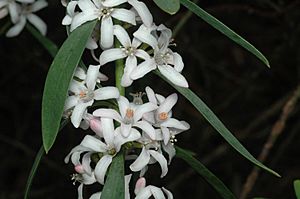Philotheca conduplicata facts for kids
Quick facts for kids Philotheca conduplicata |
|
|---|---|
 |
|
| In the ANBG | |
| Scientific classification | |
| Genus: |
Philotheca
|
| Species: |
conduplicata
|
| Synonyms | |
|
|
Philotheca conduplicata is a type of flowering plant. It belongs to the Rutaceae family. This plant is a shrub that grows only in eastern Australia.
It has oval-shaped leaves that grow close together at the ends of its branches. Its white flowers usually appear alone or in small groups of two or three.
What Does It Look Like?
Philotheca conduplicata is a shrub that can grow up to about 2 meters (6.5 feet) tall. It has smooth, thin branches.
The leaves are mostly found in groups near the ends of the branches. They are oval-shaped and slightly curved. Each leaf is about 40 to 70 millimeters (1.6 to 2.8 inches) long. They are also 4 to 14 millimeters (0.16 to 0.55 inches) wide. The leaves are folded lengthwise.
The flowers grow alone or in groups of two or three. They are found at the ends of the branches. Each flower sits on a thick stalk called a peduncle, which is about 4 millimeters (0.16 inches) long. Each flower also has a smaller stalk called a pedicel, which is 2 to 4 millimeters (0.08 to 0.16 inches) long.
Each flower has five sepals, which are broad and triangular. They have a fleshy center. There are also five white petals. These petals are oval to spear-shaped and are about 6 to 11 millimeters (0.24 to 0.43 inches) long. They are 2.5 to 3.5 millimeters (0.10 to 0.14 inches) wide. The ten stamens, which are the parts that produce pollen, are a bit hairy.
This plant usually flowers from July to September. The fruit is 6 to 9 millimeters (0.24 to 0.35 inches) long and has a beak-like shape.
How It Got Its Name
This plant was first officially described in 1970. A scientist named Paul G. Wilson gave it the name Eriostemon myoporoides subsp. conduplicatus. He published his description in a science journal called Nuytsia.
He used plant samples collected in 1905 by Joseph Maiden and Ernst Betche. These samples were found near a place called Howell, which is north of Bundarra. Later, in 2005, another scientist named Paul Irwin Forster changed its status. He made it a full species and renamed it Philotheca conduplicata. This new name was published in the journal Austrobaileya.
Where It Grows
Philotheca conduplicata grows among large granite rocks. You can find it in an area called the Granite Belt. This region is located in northern New South Wales and south-eastern Queensland in Australia.

